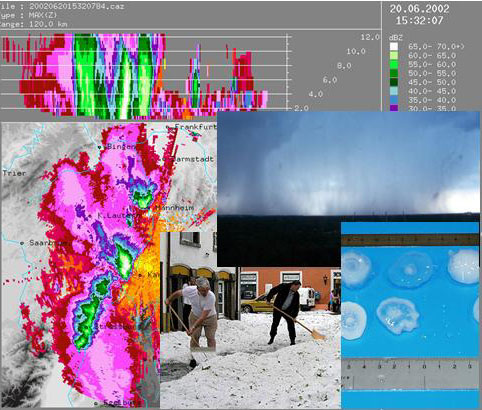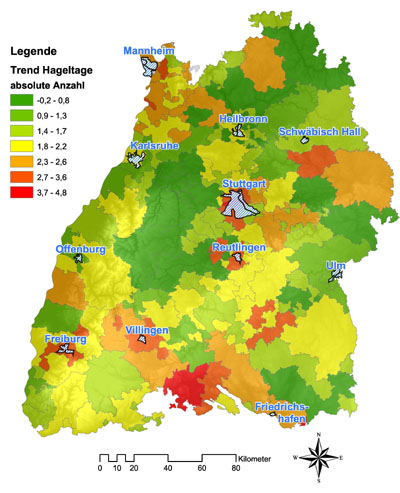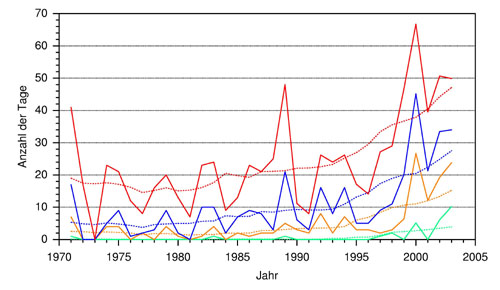KLARA: Climate Change: impacts, risks, adaptation - Probabilities and intensities of high impact weather with high potential loss
- Contact: Dr. M. Kunz
- Project Group: IMK-TRO
- Funding: Land BW
Research project KLARA (Climate change – impacts, risks, adaption) conducted in commission by the Ministry of the Environment of Baden-Wuerttemberg
Project management organization: Potsdam Institute for Climate Impact Research (PIK), State Institute for Environmental Protection
Project description
The project conducted as part of the research project KLARA (climate change – impacts, risks, adaptions) by the state of Baden-Wuertemberg examines whether an increase of thunderstorms in the past years in area of Baden-Wuertemberg as possible consequence of anthropogenic greenhouse effect can be identified.
Due to the high variability of these events, data from different measurement systems were evaluated.
- Sum of losses due to hail from the SV-building insurance company (1986-2004),
- Data of synoptic stations of the German National Meteorological Service (1949-2000),
- Radiosonde data (1971-2003),
- Data from the IMK-radar (1998-2002).
Despite strong yearly variations, both the aggregated damage losses (corrected) as well as the number of damage reports of the SV-building insurance company show an almost dramatic increase in the last 20 years. Looking at the number of hail days derived from the data gives a nearly identical picture. In total some communities show an increase of over 400% in the last 19 years (Figure 2).
A positive trend of thunderstorm events can also be observed at individual SYNOP-stations. However this result cannot simply be transferred to the whole area of Baden Wuertemberg due to the small number of events. Therefore atmospheric conditions, expressed through different stability indices, were additionally examined as necessary pre-conditions. This was done based on vertical profiles at the radiosonde located in Stuttgart between 1971 and 2003.
Especially CAPE which indicates the level of energy available for lifting in the atmosphere, increased notable both concerning the number of days where it reached a level higher than the given threshold as well as the yearly maxima. This increase can be ascribed to the strong increase of near-ground air moisture in the 1970s.
To further investigate to what extent the convection indices that were deducted from the radiosonde data, especially cape, can actually allow conclusions about thunderstorm events additional high resolution data from the IMK-radar between 1998 and 2002 were evaluated. A direct comparison between the data led to an agreement in two of three cases.
 Figure 1: Thunderstorms on radar pictures and their effects. |
 Figure 2: relative increase in number of hail days from 1986 and 2004 derived from data of the SV-building insurance company for 3-digit postal-code areas. |
 Figure 3: Number of days per year on which CAPE lay over the given threshold (5 year gliding mean represented by dotted line). |
